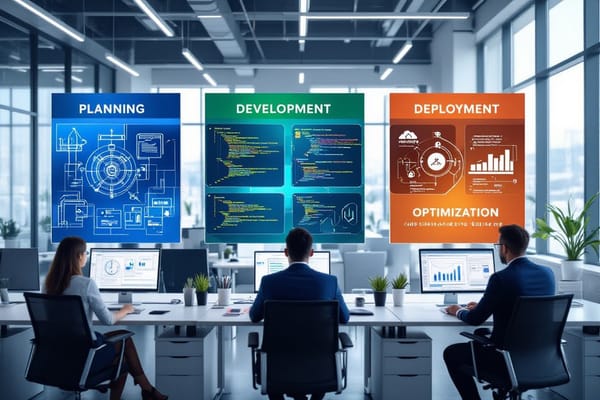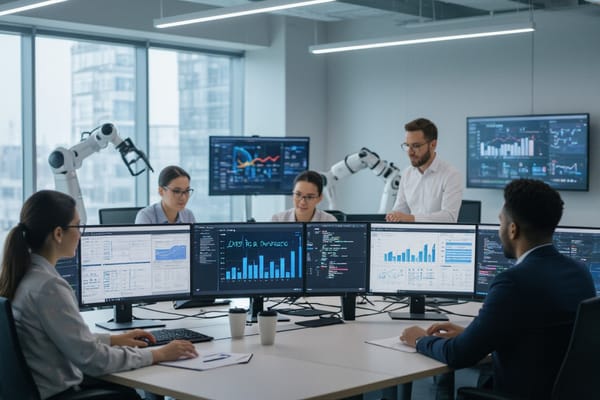The Future of Workflows: Orchestrating AI, RPA, and Human Tasks

There's a decisive shift in workflows as AI, RPA, and human tasks converge, and you must design governance, feedback loops, and task-routing that keep your operations adaptive and transparent. This post shows how to align capabilities, measure outcomes, and scale automation responsibly; you can start by reviewing frameworks such as Transforming Task Automation: The Future of Intelligent Orchestration to inform your strategy.
Key Takeaways:
- Hybrid orchestration assigns repetitive tasks to RPA, pattern recognition and decisions to AI, and exception handling to humans for efficiency and accuracy.
- Governance with explainability, audit trails, and role-based controls ensures compliance, accountability, and safe automation at scale.
- Modular, observable workflows with model management, continuous learning, and low-code orchestration enable rapid scaling and adaptation.

The Rise of AI in Workflows
As AI models plug into orchestration layers, you’ll see pattern detection, predictive routing, and dynamic SLA adjustments handled automatically. Many teams report 15–40% throughput increases when models are fine-tuned on domain data and combined with RPA for execution, allowing your people to focus on complex exceptions and outcomes.
Understanding AI Capabilities
You should expect NLP to extract entities at 85–95% accuracy on cleaned text, vision models to classify scanned documents with >90% precision after fine-tuning, and time-series models to improve demand forecasts by 10–30%. These capabilities let you automate triage, prioritize work, and surface anomalies for human review.
Case Studies of AI Integration
In pilots across finance, customer service, and supply chain, AI paired with RPA reduced manual touches and cycle times significantly. For example, invoice processing times fell from days to hours, customer inquiry routing accuracy rose above 92%, and forecast errors declined by up to 25%—metrics that directly tied to operational cost and SLA improvements.
- Global bank: invoice triage reduced processing time from 72 hours to 2 hours; 82% straight-through processing; annualized savings $3.2M.
- Telecom provider: AI routing improved first-contact resolution from 67% to 88%; average handle time dropped 22%; saved ~120,000 agent hours/year.
- Manufacturing firm: demand-forecast model cut stockouts by 35% and excess inventory by 18%, improving turnover and freeing $8M in working capital.
- Healthcare payer: claims fraud detection raised true-positive rate from 41% to 76%, reducing losses by $1.1M in the first year.
Across these examples, you’ll notice common patterns: focused data curation, iterative model retraining, and human-in-the-loop checkpoints for edge cases. Emphasize continuous monitoring—model drift appeared within 3–6 months in several pilots, requiring weekly retraining cycles initially and governance dashboards to keep your workflows stable.
- Retail pilot: training set 250k labeled receipts, model latency 120ms, OCR accuracy 94%, reduced checkout reconciliation time by 88% and returned ROI in 7 months.
- Insurance claims: deployed ensemble model using 120k historical claims, precision 0.78, recall 0.85; automated 60% of low-risk claims, cut adjudication cost per claim by 42%.
- Logistics optimization: routing AI trained on 3 years of telemetry, improved on-time delivery by 16%, cut fuel cost 9%, and reduced average route time by 23 minutes.
- HR onboarding: conversational AI handled 70% of routine queries, average response time <30s, reduced manual HR touchpoints by 68% and improved new-hire activation rate by 12%.

Robotic Process Automation (RPA)
You can deploy RPA to automate repetitive, rule-based work such as invoice processing or account reconciliation, achieving 30–70% faster cycle times and reducing errors. Vendors like UiPath, Automation Anywhere and Blue Prism dominate implementations that scale bots across finance and HR. For technical background and trends, see (PDF) The Future of Workflows: How AI-Enhanced RPA Is ....
Defining RPA and Its Benefits
You should view RPA as software robots that mimic human interactions with applications to execute rules-based tasks. Typical benefits are 20–50% reductions in labor hours, improved accuracy, 24/7 throughput, and ROI often realized within 6–12 months; for example, automating purchase-to-pay can cut invoice backlogs by half and speed approvals from days to hours.
Challenges in RPA Implementation
You'll encounter brittle automations, legacy-system fragility, and inadequate governance that can drive maintenance costs up to 60% of total program spend if left unchecked. Scaling often stalls without process standardization, while security and credential management create additional risk that must be addressed through robust controls and monitoring.
When you scale RPA, budget for ongoing maintenance—expect a 20–30% annual escalation—and staff a central COE (commonly 5–10 FTEs per 100 bots) to handle exceptions, versioning, and vendor upgrades. Pairing ML-based document understanding can reduce exception rates from about 25% to under 10% in invoice workflows, and phased rollouts after process redesign (a common insurer case cut claims cycle from 10 days to 48 hours) help ensure bots deliver sustained value.
The Role of Human Tasks in Automated Workflows
You rely on human tasks for exception handling, ethical judgment, and customer empathy that AI and RPA can’t reliably provide; many RPA deployments achieve 80–90% straight‑through processing, leaving roughly 10–20% of cases for human review. Set confidence thresholds (for example, <85%) to trigger human involvement, and design audit checkpoints for compliance sign‑offs. In loan processing and fraud investigations, for instance, humans still resolve nuanced disputes and override automated decisions when contextual evidence or legal interpretation is required.
Balancing Automation and Human Input
Start by mapping decision points and applying patterns like human‑in‑the‑loop for approvals and human‑on‑the‑loop for oversight. Use measurable thresholds (confidence <85%, more than three failed automation retries) to route work to specialists and choose synchronous tasks for sub‑2‑minute approvals versus asynchronous queues for investigations. Instrument SLAs and queue priorities, and track KPIs such as cycle time, error rate, and rework percentage to tune the split between automation and human labor.
Skills Needed for the Future Workforce
You should cultivate a T‑shaped team: broad digital fluency plus deep roles in AI, process design, or compliance. Key skills include prompt engineering, process mining, RPA configuration (UiPath/Automation Anywhere), data analysis (SQL/Python), ethical reasoning, and customer communication. A practical target is 1–2 AI/RPA‑literate specialists per 8–12 operational staff to accelerate adoption and troubleshoot edge cases.
For implementation, prioritize role‑based learning paths: 6–12 week bootcamps for RPA developers, 3–6 month data upskilling for analysts, and 6–9 months of on‑the‑job rotations to reach proficiency. Hire or train automation architects, business analysts with process‑mining experience, human reviewers trained in compliance, and a governance lead. Track outcomes by measuring time‑to‑competency, error reduction, and throughput improvements to justify continued investment in skill development.
Orchestrating AI and RPA
Link AI inference, RPA bots, and human approvals through event-driven pipelines and stateful workflow engines. You can chain an OCR+LLM validation step to an RPA bot for data entry, triggering human review only on low-confidence cases; in practice organizations report up to 70% reduction in manual work for document workflows. Use timeouts, retries, and idempotent actions to handle transient model or UI failures, and measure end-to-end latency — sub-second inference often matters for customer-facing flows.
Frameworks for Workflow Orchestration
Use BPMN engines like Camunda or Zeebe when you need visual process models and human task routing; they map easily to task inboxes and SLAs. If you prefer code-first durable workflows, Temporal (or Cadence) provides deterministic replay, long-running state, and built-in retry/compensation semantics. For scheduled ETL or data pipelines, Apache Airflow is still dominant, while Netflix Conductor suits microservice choreography — choose by developer experience, latency needs, and human-task support.
Tools and Technologies for Integration
Integrate via message brokers (Kafka, RabbitMQ) for eventing and Redis Streams for lightweight queues, exposing model endpoints through REST, gRPC, or platforms like Seldon and BentoML. You can orchestrate enterprise RPA (UiPath, Automation Anywhere, Blue Prism) via APIs or native connectors and use iPaaS (MuleSoft, Workato) for SaaS glue. Make sure your API gateway and OIDC-based auth protect endpoints and that circuit breakers throttle downstream model or UI automation spikes.
Operational patterns matter: instrument traces with OpenTelemetry, collect metrics in Prometheus, and centralize logs in Elasticsearch or Splunk so you can correlate LLM calls, RPA runs, and human approvals. Cache or batch model inference to reduce per-request cost (batching can lower spend by 50–80% at scale), and employ deduplication tokens and idempotent actions to avoid double work. A common stack is Temporal for durable workflows, Kafka for events, HashiCorp Vault for secrets, UiPath Orchestrator for robot execution, and OpenTelemetry+Prometheus for observability — this combination gives you retries, audit trails, and safe replay of failed tasks.
Measuring Success in Automated Workflows
Track objective outcomes like throughput, cycle time, error rates, and user satisfaction to quantify impact: a targeted 40–60% reduction in end-to-end processing time or a 30% drop in manual touchpoints signals progress. You should combine financial metrics (cost per transaction, ROI within 12 months) with operational metrics (SLA compliance, model precision) and human metrics (employee time saved, NPS) to form a balanced scorecard that guides optimization.
Key Performance Indicators (KPIs)
Focus on automation rate (% tasks automated), exception rate, mean time to resolution (MTTR), cost per transaction, model accuracy (precision/recall), and SLA adherence. Aim for benchmarks like >70% automation rate and <5% exception rate where feasible. Use transaction-level telemetry and dashboards to correlate KPI shifts with deployments—when model accuracy drops 3–5% post-release, flag retraining and rollback triggers automatically.
Continuous Improvement Strategies
Adopt iterative experiments: A/B test workflow variants, run process-mining monthly, and schedule model retraining on labeled exceptions every 2–4 weeks. You should use controlled rollouts (canary deployments for bots and models), maintain versioned artifacts, and automate rollback criteria so you can safely tune flows without customer impact.
Implement a feedback loop that routes exceptions and human adjustments into a labeled dataset automatically; for example, a telecom operator lowered exception spikes by 30% after biweekly retraining. Combine quantitative A/B testing with weekly retrospectives, enforce change governance (approval gates, runbooks), and track uplift using cohort analysis so you can attribute improvements—expect incremental model accuracy gains of 5–12% per focused retraining cycle when quality data is fed back consistently.
Future Trends in Workflow Automation
Emerging Technologies on the Horizon
Foundational models like GPT-4 and multimodal successors, edge AI for low-latency inference, digital twins, and advanced process-mining reshape how you assemble workflows. Tools such as Celonis, UiPath, and Automation Anywhere demonstrate hybrid orchestration in finance and manufacturing, while low-code platforms accelerate adoption. McKinsey estimates about 60% of occupations have at least 30% automatable activities, so you’ll see explainable AI and blockchain audit trails paired with human oversight to balance speed, transparency, and compliance.
Predictions for the Next Decade
Within a decade, orchestration layers will route tasks in real time between AI agents, RPA bots, and humans, cutting routine cycle times by an estimated 20–40% and reducing exception rates. You’ll depend on policy-driven governance, human-in-the-loop checkpoints for high-risk decisions, and standardized evaluation for model fitness. Case studies in supply chain and banking already show faster settlements and fewer manual escalations when hybrid automation handles standard cases.
You’ll need focused change management: reskilling programs that teach data literacy and exception handling, plus KPIs tied to throughput, error rates, and customer experience. Expect pilot ROI windows of roughly 6–18 months for midsize initiatives, driving platform consolidation and richer orchestration APIs. Process discovery will continuously feed automated playbooks, and standardized AI evaluation suites will become mandatory before models are trusted with regulated or safety-critical tasks.
To wrap up
Hence, you must design workflows that balance AI decisioning, RPA execution, and human judgment, aligning roles, governance, and metrics so your processes scale safely and adapt to change. You should invest in interoperable platforms, clear escalation paths, and continuous monitoring so your teams trust automation and focus on higher-value work. With disciplined orchestration, you’ll achieve resilient, efficient workflows that evolve with new capabilities.
FAQ
Q: What does orchestrating AI, RPA, and human tasks look like in practice?
A: Orchestration coordinates automated components (ML models, RPA bots) and human actions into end-to-end processes. A workflow engine or low-code platform routes data and decisions: AI extracts and classifies inputs, RPA executes rule-based steps, and humans handle exceptions or judgment calls. Orchestration manages sequencing, parallelism, SLAs, retries, and audit trails, enabling dynamic handoffs based on confidence scores, business rules, or real-time events. Typical implementations use APIs, message buses, BPMN-style flow definitions, and monitoring dashboards to maintain visibility and control.
Q: How should organizations handle governance, security, and compliance for hybrid workflows?
A: Establish policies for data access, model validation, and auditability. Use role-based access control, encryption in transit and at rest, and data minimization. Implement model lifecycle practices (versioning, bias testing, performance monitoring) and keep immutable audit logs linking inputs, decisions, and actions. Define escalation paths for exceptions, enforce separation of duties where needed, and map workflows to regulatory requirements (e.g., GDPR, HIPAA). Regular risk assessments, penetration testing, and incident response plans ensure ongoing compliance and security.
Q: What skills, metrics, and roadmap help adopt orchestrated AI+RPA+human workflows?
A: Build cross-functional teams: process designers, automation engineers, data scientists/ML engineers, integration developers, DevOps, and change managers. Train citizen developers for low-code tasks and upskill reviewers for exception handling. Track metrics such as cycle time, error rate, manual-touch percentage, cost per transaction, bot and model utilization, SLA compliance, and business impact (revenue, savings, customer satisfaction). Start with high-value pilot use cases, define KPIs, validate ROI, iterate with feedback, then scale with standardized platforms, governance, and training programs.



